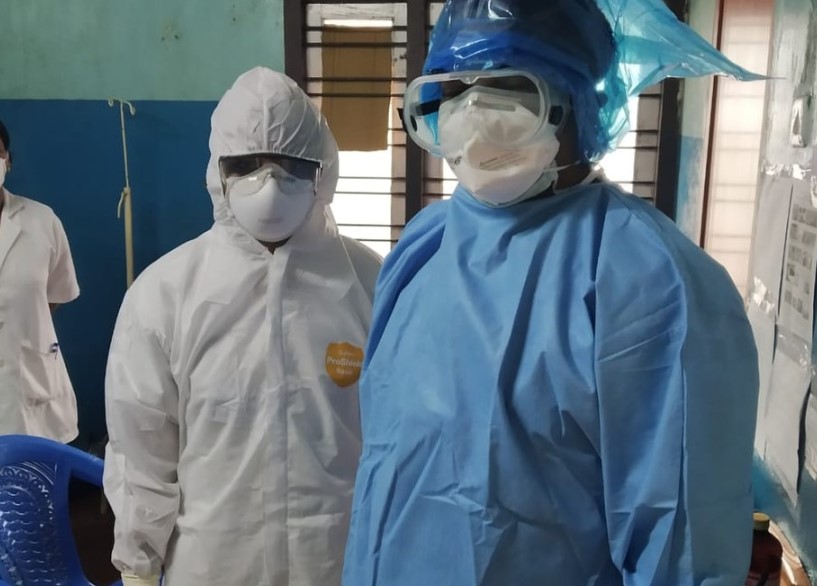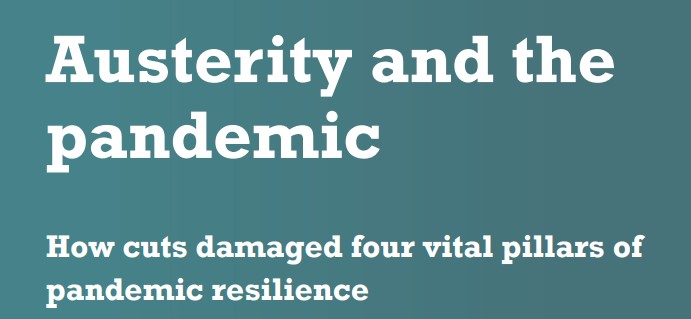By Maggie Fenwick, former UNISON health branch secretary
A recent TUC report, called Austerity and the Pandemic, highlighted the complete lack of preparedness of the government and public services in the period leading up to the Covid outbreak. The TUC report firmly puts the blame for the problems in public services down to an austerity programme, which “cost the nation dearly…the consequences were awful and tragic”
The report noted that Tory government austerity meant that “public Services capacity was damaged by steep cuts to almost every part of the public sector”.
It goes on to study the country’s preparedness for Covid in relation to safe staffing levels, capacity and resources, and the safety security net of social security and finally health and safety at work. The report details how safe staffing levels were undermined by many years of pay caps, and pay freezes.
I can support this claim, having worked in the NHS for most of my life, and I would argue that pay caps, with 0% and 1% pay rises the norm, had been in place in the NHS for quite a few years before that. The poor pay and conditions has led to greatly increased turnover of staff and made it difficult to recruit.
In the NHS hospital where I worked, for instance, and being a shop steward, I was shown the list of vacancies. I was shocked to see that it wasn’t so much of a list, but a 2.5 cm pile of papers, ie job descriptions. Each piece of paper was a vacancy.
Nurses per capita increased way below the demand for care
The TUC report makes the point that the number of nurses per capita in the UK between 2010-2020 grew by less than 1%, yet the demand for care rose by a third. By 2019, because of the poor pay rises the average NHS worker had been given, they were earning £3,000 less in real terms than in 2010. I remember being disappointed when we had 1% pay rises, as this amounted to about £20 or £25 a month (before tax), depending on which pay band workers were on.
My union branch members (UNISON) were very disappointed and angry. Some admin and clerical staff even left the NHS without having a job to go to. A further complication within the health and care workforce was that at the beginning of the pandemic, nearly a quarter of care workers were employed on zero hours contracts!

The TUC report moves onto education and Social Care. Local authority core spending power was drastically cut, by a third, between 2010 and 2020. School funding per pupil was cut in England Scotland and Wales. Local Authorities therefore, were less able to cope with the higher referrals and complex cases in both adult and children in social care and in dealing with homelessness. All of these problems stretched local authority budgets further.
Not only were there cuts in the NHS, the social care sector and education, but social security was also cut. The TUC paper talks of Social Security as a ‘safety net’, but it was damaged enormously by direct cuts, freezes on benefits and reforms that reduced entitlement to help, so it was narrowed down to fewer people.
Steep cuts during the Tory-LibDem coalition.
Many of these cuts took place between 2010 and 2016, the Tory years of Cameron and Osborne, when the Tories were supported most of that time by the Lib-Dems. The cuts increased poverty, and living in poverty led to increased risk of exposure to serious health conditions with Covid 19.
After 2010, £14bn was cut from support to households thought social security. Families not in work lost on average £1,160 a year after 2010, and a working family lost on average £460. Disabled people lost too, on average £1,200 of annual support, when comparing 2021 with 2010.
The TUC also shows that health and safety at work was compromised, especially for key workers and those who could not work at home. We have to ask, of course, what about health and safety for home workers? Did councils, the NHS and other organisations and companies give any thought to health and safety when workers had to work at home? I certainly didn’t get a risk assessment or health and safety assessment.
Massive industrial-scale corruption
Funding for the Health and Safety Executive, the organisation supposedly responsible for workplace health and safety, has also been cut. Inspections and enforcement in 2021/22 was 43% lower than than it had been in 2009/10 in real terms. Staff numbers at the HSE have been cut by 35% since 2019, and the number of workplaces which were investigated and inspected fell by a massive 70% between 2010 to 2020.
As the TUC general secretary Paul Nowak has said, “To learn lessons and save future lives, we must take an unflinching look at the choices made by our leaders in the years before the pandemic…In the NHS and Social Care, funding cuts put staff levels in the danger zone, cuts to Social Security pushed many more people below the poverty line to infection. And cuts to health and safety left workers exposed to rogue employers who cut corners and put their lives at risk.’
As the TUC General Secretary has said in the report, austerity cost working class people very dearly, not only by direct cuts on their living standards, but by leaving society hugely unprepared for the pandemic. Far too many workers were left unprotected and the consequences were tragic.
The other side of the pandemic coin – but not dealt with by the TUC report – was the massive industrial-scale corruption that went with Covid. It was only necessary to send a WhatsApp message to an MP or peer for Tory friends and associates to get multi-million pound contracts, often for a useless service, like unuseable PPE. The government threw hundreds of millions of pounds at their pals in business, yet they claim they cannot pay NHS staff a decent wage.
Both sides of the pandemic – the complete lack of preparedness due to austerity, and the corrupt practices – have to be taken on board in any discussion about the ‘lessons’ of Covid and any preparations we might need for a future pandemic.
The report can be downloaded from the TUC website here and would provide a good starting point for any discussion in a trade union branch or Labour Party meeting.



